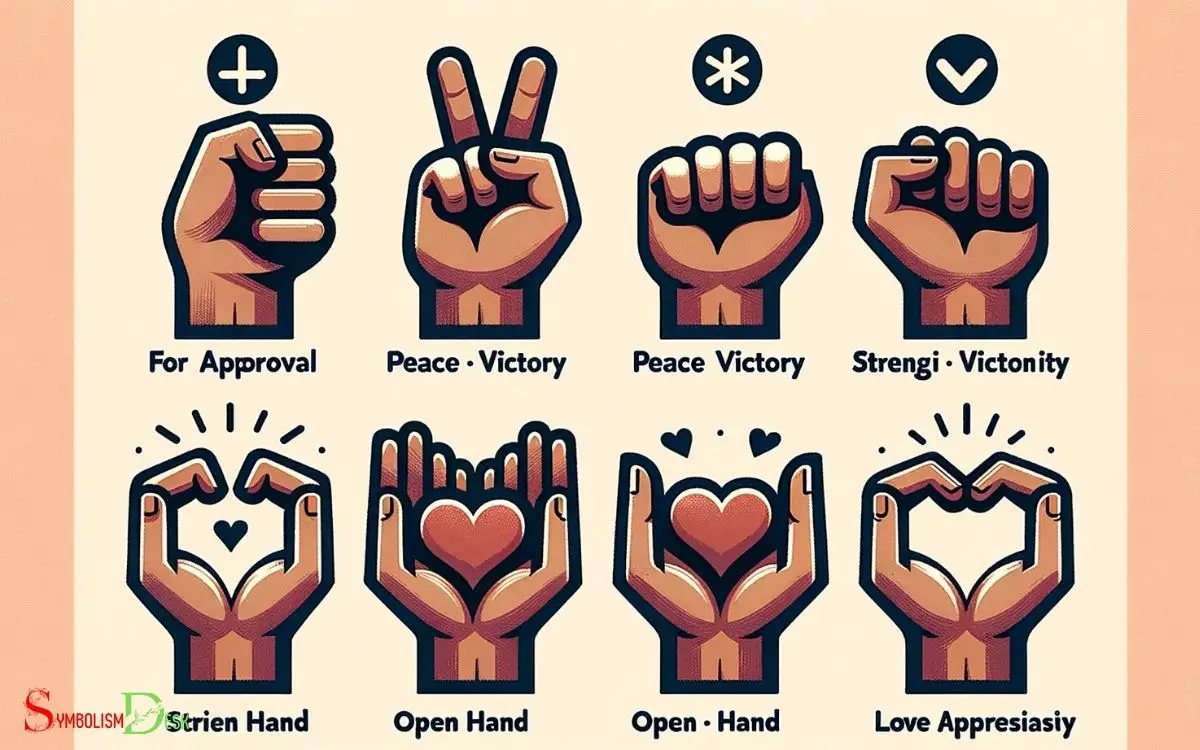Symbolic Hand Emoji Meaning Chart: Explain!
Discover the meanings of hand emojis with our detailed Symbolic Hand Emoji Meaning Chart. This guide helps decode the emotions and expressions conveyed through digital hand gestures.
Hand emojis are used in digital communication to express a variety of emotions and actions. Each emoji has a unique meaning, often rooted in cultural gestures or common usage.
For example:
Thumbs Up: Agreement or approval
Folded Hands: Gratitude or prayer
Peace Sign: Victory or peace
Explore the intricate world of hand emojis with our in-depth Symbolic Hand Emoji Meaning Chart. This resource is essential for mastering the art of conveying feelings and thoughts through hand gestures in your digital interactions.
Our chart provides clear interpretations of the diverse hand emojis, enabling you to express a wide range of emotions, actions, and expressions effectively. With this knowledge, you can unlock the full potential of hand gestures in your online communication.

Key Takeaway
10 Symbolic Hand Emoji Meanings Chart
| Symbol | Meaning and Symbolism |
|---|---|
| Raised Hand | A gesture for greeting, attention, or signaling to stop or pause. |
| Waving Hand | A friendly gesture used for greeting or saying goodbye. |
| Raised Back of Hand | Often used to signify “stop” or “halt” or for emphasis. |
| Hand with Fingers Splayed | Signifying openness, friendliness, or a desire for a high-five. |
| Raising Hands | Expresses celebration, praise, excitement, or accomplishment. |
| Handshake | Represents an agreement, partnership, trust, or cooperation. |
| Folded Hands | Conveys gratitude, prayer, respect, humility, or seeking blessings. |
| Palms Up Together | Indicates openness, acceptance, or a desire to receive something. |
| Crossed Fingers | Symbolic of hope, luck, optimism, or making a wish. |
| Love-You Gesture | Forms the “I love you” sign in American Sign Language. Represents affection, love, or care. |
| Sign of the Horns | Associated with excitement, celebration, or a carefree attitude. |
| Vulcan Salute | From “Star Trek,” signifies “Live long and prosper,” representing goodwill and best wishes. |
The Power of Hand Emojis
The power of hand emojis lies in their ability to convey nuanced and complex emotions with just a simple gesture.
These tiny digital symbols have transcended linguistic barriers, allowing individuals from diverse cultures to communicate universal emotions such as love, gratitude, and victory.
The thumbs-up emoji, for instance, universally signifies approval and encouragement, while the folded hands emoji represents gratitude or prayer in various cultures.
Furthermore, hand emojis can express non-verbal cues such as peace, solidarity, or even sassiness, adding layers of meaning to digital conversations.
Their simplicity and universality make hand emojis a powerful tool for effective communication in the digital age, enabling individuals to express a wide range of emotions and gestures with just a few taps on their screens.
Understanding Common Hand Gestures
An exploration of five common hand gestures and their diverse cultural interpretations will shed light on the nuanced meanings conveyed through symbolic hand emojis.
- The thumbs-up gesture, often used in Western cultures to signify approval, can be seen as offensive in some parts of the Middle East.
- The ‘okay’ gesture, formed by connecting the thumb and index finger in a circle, carries positive connotations in the United States but is considered an insult in countries like Brazil and Turkey.
- Pointing with the index finger, commonly used to indicate direction, can be deemed impolite in certain Asian cultures if directed at a person.
Understanding these cultural variations in hand gestures is crucial for effective communication, both in person and through digital mediums.
It also provides valuable insight into the interpretation of hand emojis across different cultural contexts. This understanding will serve as a foundation for decoding hand emoji meanings in the subsequent section.
Decoding Hand Emoji Meanings
Exploring the nuanced interpretations of hand emojis is essential for understanding their symbolic meanings across various cultural contexts.
Hand emojis can convey a wide range of meanings, and decoding them requires an understanding of their cultural significance.
Below is a table that illustrates some common hand emojis and their potential meanings in different cultural contexts:
| Hand Emoji Interpretation | Emotive Significance |
|---|---|
| Raised Hand | Conveys warmth and friendliness. Suitable for expressing affection or gratitude. |
| Raised Hand (Stop) | Signifies a halt or rejection, adding nuance to digital interactions. |
| Thumbs Up | Indicates approval or agreement. |
| Thumbs Down | Represents disapproval or disagreement. |
Understanding the diverse interpretations of hand emojis is crucial for effective communication, especially in a globalized world where cultural nuances play a significant role in digital interactions.
Exploring Symbolism in Hand Emojis
The symbolism in hand emojis spans a wide range of gestures, each carrying its own cultural and emotional significance. From the thumbs-up to the raised fist, these gestures hold various interpretations across different societies and contexts.
Understanding the cultural and emotional connotations behind hand emojis can provide valuable insight into the nuances of communication in the digital age.
Hand Emoji Gestures
Symbolism in hand emojis can be analyzed through the various gestures represented by these symbols. For example, the thumbs-up emoji is often used to convey approval or agreement, while the facepalm emoji represents frustration or embarrassment. Similarly, the peace sign emoji is commonly associated with the concept of peace or tranquility. Another aspect of symbolism in hand emojis is the Sims feet symbol meaning, which can vary depending on the context in which it is used. Overall, the use of hand emojis allows for the expression of a wide range of emotions and ideas in digital communication.
Each gesture carries its own meaning and can convey different emotions and messages. When users employ hand emojis, they are utilizing these symbolic gestures to express themselves effectively.
Some common hand emoji gestures include:
1. Thumbs Up: This gesture signifies approval, agreement, or satisfaction.
2. Peace Sign: Often used to convey a sense of peace, tranquility, or a friendly greeting.
3. Rock-On Hand: This gesture is associated with rock music and can represent a feeling of excitement or a love for rock and roll culture.
Understanding the symbolism behind these hand emoji gestures allows for more nuanced and meaningful communication in digital conversations.
Cultural Interpretations of Hands
Cultural interpretations of hands in emojis reveal diverse and significant symbolism across various societies and traditions.
The meanings attributed to hand gestures can vary widely depending on cultural context, making it essential to consider these nuances when using hand emojis.
Below is a table highlighting some common cultural interpretations of hand gestures in emojis:
| Gesture Interpretation | Cultural Significance |
|---|---|
| Bowing | Respect and humility, common in Asian cultures. |
| Namaste | Greeting and respect, particularly in Indian culture. |
| Handshakes | Formal greeting and agreement in many Western cultures. |
| Thumbs Up/Down | Approval (Up) or disapproval (Down) in many cultures. |
| Waving | A friendly greeting or farewell gesture worldwide. |
| Finger Snap | Expression of approval or excitement in some cultures. |
| Crossed Fingers | Symbolizing hope or good luck in various cultures. |
| Finger Pointing | Can be seen as rude or accusatory in some cultures. |
| Clapping Hands | Applause or celebration across diverse cultures. |
| Peace Sign | Sign of peace or victory, recognized globally. |
Understanding the cultural significance of hand emojis is crucial for effective communication, as it allows for respectful and accurate expression of emotions and actions across diverse cultural backgrounds.
Emotional Expressions Through Hands
Exploring the emotional expressions conveyed through hand emojis, it is crucial to recognize the nuanced symbolism that underlies these digital gestures across diverse cultural contexts. Hand emojis, beyond their literal meanings, carry profound emotional connotations. They serve as powerful tools for expressing sentiments and attitudes in digital communication.
The raised hands emoji, often symbolizing celebration or praise, can also denote gratitude or even surrender, depending on the context and cultural perspective.
The folded hands emoji, commonly interpreted as a sign of prayer or gratitude in some cultures, may also convey pleading, hopefulness, or a high-five in others.
The handshake emoji, traditionally representing agreement or greeting, can also signify trust, compromise, or even a challenge within varying cultural frameworks.
Understanding the multifaceted emotional expressions embedded in hand emojis is essential for effective and culturally sensitive communication in the digital sphere.
Unveiling the Secrets of Hand Emojis
Interpreting hand gestures in digital communication enhances understanding. For instance, a raised hand conveys warmth, while a hand in a stop position signals rejection.
A thumbs-up indicates approval, and a thumbs-down signifies disapproval. Decoding these gestures fosters clearer and more precise online exchanges.
What Does the Hand Emoji Symbolize in Visual Signs and Imagery?
The hand emoji holds great significance in the symbolic meaning of visual signs and imagery. Depicting gestures such as waving, high-fiving, or thumbs up, it symbolizes communication, connection, and emotions. Its versatile use makes it a powerful tool for conveying various messages in digital communications.
Interpreting Hand Gestures in Emojis
In understanding hand gestures in emojis, it is essential to consider the cultural interpretations and the emotive significance of these gestures.
Hand emojis convey a range of meanings and emotions, with each gesture holding symbolic value across different cultures and contexts.
Exploring these points will provide insight into the nuanced ways in which hand emojis are interpreted and understood in digital communication.
Cultural Emoji Interpretations
Understanding the cultural nuances of hand gestures in emojis requires a nuanced approach that accounts for diverse interpretations across different societies.
When interpreting hand emojis across cultures, it’s important to consider:
- Regional Variances: Hand gestures hold distinct meanings in various regions. For instance, the ‘ok’ gesture can be offensive in some cultures.
- Historical Context: Certain emojis may carry historical connotations, such as the peace sign being associated with the peace movement of the 1960s.
- Social Customs: Emojis can reflect social customs and etiquette. The gesture of folded hands can convey gratitude or a greeting in some cultures, while in others, it may have a religious significance.
These factors illustrate the complexity of cultural interpretations of hand emojis, emphasizing the need for sensitivity and awareness. This understanding paves the way for exploring the emotive significance of gestures.
Emotive Significance of Gestures
Interpreting hand gestures in emojis requires careful consideration of their emotive significance across different cultural contexts. Hand gestures play a significant role in non-verbal communication and can convey a wide range of emotions and meanings.
Emojis that depict hand gestures are no exception, and their interpretations can vary based on cultural and regional differences. Understanding the emotive significance of these gestures is essential for effective communication in the digital realm.
Certainly, here is a table illustrating the emotive significance of various gestures without emojis:
| Gesture | Emotive Significance |
|---|---|
| Thumbs Up | Approval or agreement |
| Open Hand | Stop or halt |
| Raised Fist | Rock on or celebration |
| Open Palm | Greeting or farewell |
| Cupped Hands | Holding or offering |
| Crossed Fingers | Good luck or hope |
| Clapping Hands | Applause or appreciation |
| Folded Hands | Prayer or supplication |
| Handshake | Agreement or greeting |
| Hand Heart | Love or affection |
| Covering Mouth | Shyness or embarrassment |
| Flexed Biceps | Strength or determination |
| Hand to Chin | Thoughtfulness or contemplation |
| Raised Hands | Celebration or victory |
Conclusion
In the intricate web of communication, hand emojis play a vital role in conveying nuanced meanings and emotions. They serve as symbolic representations of human gestures, adding depth and complexity to digital conversations.
By understanding the common hand gestures and decoding their meanings, we can unveil the secrets of hand emojis and explore the rich symbolism they carry. Just as a hand gesture can speak volumes in person, hand emojis hold the power to speak volumes in the digital realm.






